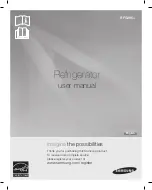
27
3
1 2
general information
trips and absences:
On prolonged absences, disconnect
the plug from the wall outlet. Leave your refrigerator
empty and clean. This includes the ice trays. Leave the
door ajar, placing an object behind it to prevent it from
closing. This facilitates air circulation and stops bad odors
from forming.
moving:
If you need to place the refrigerator in a horizontal
position in order to transport it, place it only on its left
side (when viewing your refrigerator from the front).
Before changing your refrigerator’s location, screw the
leveling screws in as far as they will go.
problems with the electrical supply:
The majority of power
cuts are corrected in a few hours. The interior temperature
of your refrigerator will not be affected for 4 hours. If
the electrical failure persists for more than 6 hours we
suggest that you introduce ice bags in both compartments
to help to preserve foods.
Your refrigerator will not be affected in any way on the
resumption of power.
normal operating sounds:
Some sounds are normal when
your refrigerator is operating.
Following is a table describing the different sounds that
are characteristic of its functioning:
crunching:
Crunching is heard when ice breaks. This is the
same noise that is heard when ice trays are removed from
the freezer and exposed to room temperature.
compressors:
This is a normal sound caused by the running
of the motor. It means the compressor is functioning.
gas expansion:
Characteristic of the expansion of gas in
the refrigeration system. It is similar to the noise heard
when filling a gas cylinder.
1






































